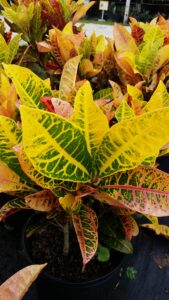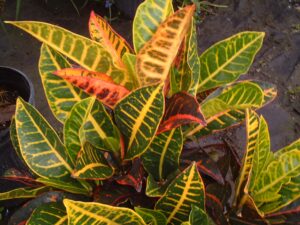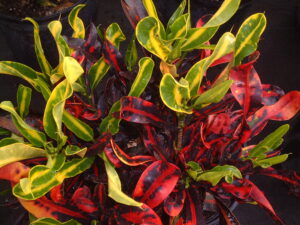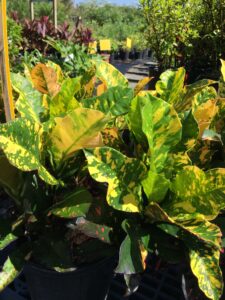S & J Nursery’s Croton Plants for
Northeast Florida Landscapes
( Codiaeum variegatum)
Crotons….Instant Tropical Appeal for the North Florida Garden
Big bold color is the signature of any croton selection. Large, thick, brightly
colored, and glossy foliage adds an instant tropical appeal to your Northeast Florida landscape. Crotons thrive in hot humid climates making them a fuss free landscape plant selection from March to November. They look great all summer long with no trimming and no fuss right through the Thanksgiving holiday and sometimes even to Christmas, depending on the winter weather. They give you 9 or more months of fuss free curb appeal and foliage color for pool patio’s, decks, garden accents, entryway containers and more.
Crotons are winter hardy in zones 10-11, so for us here in the Jacksonville and St. Augustine area landscapes, Croton plants will need some winter protection to ensure they survive to regrow again the following season.
Protecting Your Croton Plants From Winter Temperatures
When temperatures begin to drop below 50 degrees Croton plants can start to loose leaves, stems will be damaged when temperatures drop below 35.
Although Crotons can regrow from winter damaged plants the following year, here’s a few tips to help you keep these tropical beauties happy and get a head start on next springs growth!
– Never trim your Croton plants after August. That will cause them to put out a new flush of growth and make them more sensitive to freezing temperatures. The earlier you trim during the summer, the better off your Croton plants will be.
– Keep your plants healthy and happy with a slow release plant food like
Osmocote during the summer. And give them a dose of Epsom salt in fall before winter temperatures begin to drop. Healthy plants will take the cold better than a stressed or weak plant and regrow quicker the following spring when cold damaged
– NEVER trim off cold damaged foliage until all danger of frost has passed.
This is essential when dealing with tropical and subtropical plants here in the Jacksonville and St. Augustine area landscape. Removing that damaged foliage just opens up the trunks close to the base of the plant to damage
from the next frost that comes by. I know its not pretty, but those burnt leaves and stems offer protection to the trunk and can be the difference between your plant re growing in April from the branches instead of July from the root system or even worse, not at all!
– When planted on the South side of the house, under large trees or into
microclimate areas where frost will stay off the leaves, your Crotons may well make it through winter here in the St. Augustine area landscapes with just a bit of protection from a cloth on nights with freezing temperatures.
– Try Planting your Crotons in the container and lifting them out of the landscape, bring them indoors and enjoy them as houseplants till the weather warms again in spring.
– When leaving your crotons in ground you can protect the base of the stem by loosely piling up straw or hay around the bottom foot of the plant, remove the straw in spring or spread it out as mulch into the surrounding areas. Trim off all damaged stems and foliage, fertilize and your Croton
plant is ready to get growing.
– If you are not willing to take a risk on loosing your Croton plant, or you
live in a more Northern climate, you may want to take more drastic measures to ensure next years plantings! Crotons root easily, try taking cuttings from the tips of your plants at the end of summer to plant out next
spring! Here’s how…
-
(around July or August) trim 4- 6 inch long pieces from the tips of your Croton plant you want to overwinter
-
remove the bottom set of leaves
-
place your stem cuttings into a small terra cotta pot filled with moist soil
-
place a few chopsticks in the pot making sure the chopsticks stand up above the foliage of the plant by a few inches
-
cover your pot with plastic wrap then cover over the chopsticks forming a miniature greenhouse.
-
Cuttings should root in 3-4 weeks if they are kept moist, you may need to check the soil if you no longer see condensation forming inside your saran wrap greenhouse. Add water as needed and recover.
-
When the cuttings have formed roots, remove the cover and allow to grow on a sunny windowsill till spring!
S & J Nursery Croton Selections
for the Northeast Florida,
Jacksonville | St. Augustine area landscape





